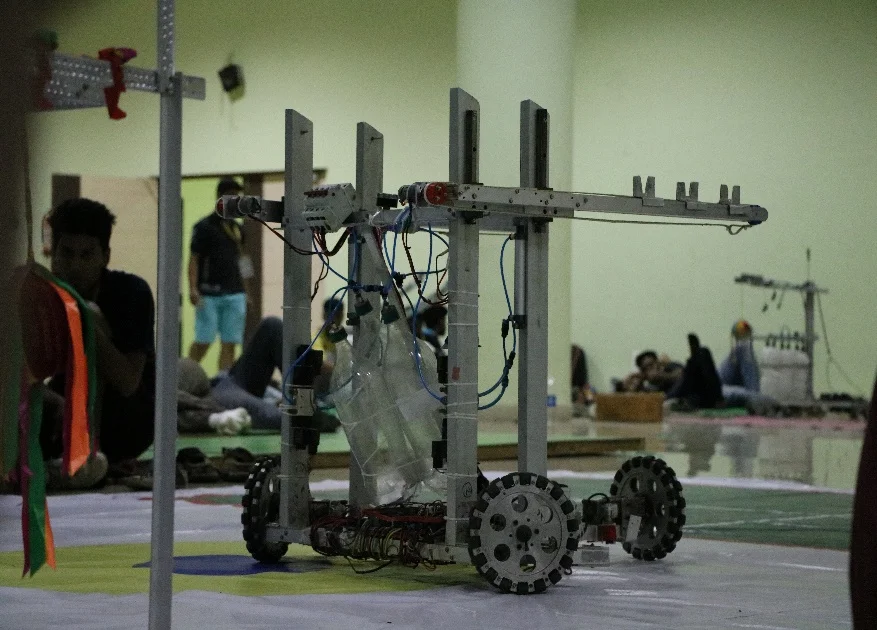
The Manual Bot utilized a 3-wheeled chassis with omni-wheels arranged at 120 degrees
for optimal stability. It was powered by brushed DC motors, with forward motion achieved
by braking one wheel while moving the other two. However, smooth sideways motion proved
difficult due to differences in the PWM-to-RPM mappings between the two motor drivers
used - a SmartElex 13S for two wheels and a Hercules 24V for the third. This mismatch
in the speed control between drivers meant the wheels rotated at unequal speeds for
the same PWM signal, hampering precise sideways movements. Overall, the 3-wheel
omni-drive provided solid forward mobility but struggled with lateral motions
due to the inconsistencies between the installed motor drivers.
It utilized 2 SmartElex 13S motor drivers to independently control two of the wheels,
while the third wheel was driven by a Hercules 24V motor driver. To actuate the pneumatic
piston shuttlecock transfer arms, it implemented 2 DCVs (direct current valves).
Control was handled through an Android application called "Blynk" that sent wireless
commands to a Raspberry Pi mini-computer, which then communicated instructions via serial
to an Arduino Mega microcontroller. The team originally installed a photoswitch for
automatic braking based on surface markings, but it failed during competition due to
the unreliability in detecting the white markings against the variable green background.
Overall, the Manual Bot combined SmartElex, Hercules, and Arduino components for drive
control, while implementing a Raspberry Pi and custom Android app for the first time to
enable wireless control and telemetry.
The Manual Bot utilized an innovative shuttlecock transfer mechanism mounted on the chassis.
This consisted of two pairs of aluminum channel arms arranged vertically on the frame.
The arms were actuated up and down using pneumatic pistons connected to custom air chambers
that stored compressed air. Conveyor belts powered by geared DC motors lined the arms to
push the shuttlecocks forward once loaded. Grabbing hooks were mounted along the arms
to securely hold and selectively release the shuttlecocks. This integrated system of
pneumatic arm motion, motorized conveyors, and grabbing hooks enabled the Manual Bot
to pick up shuttlecocks from the field rack, temporarily store them on the mobile
chassis, and precisely transfer them one at a time to the Automatic Bot upon approach.
The transfer mechanism provided key game-specific functionality to deliver shuttlecocks
between the team robots.
The Manual Bot had a specific role dictated by the competition guidelines.
It started matches positioned in the designated "Manual Bot Starting Zone".
From there, it was programmed to drive to the "Loading Zone" and pick up
the normal shuttlecocks from the field rack one at a time using its transfer mechanism.
It then approached and sequentially transferred each normal shuttlecock to the Automatic Bot.
The Manual Bot was restricted to only picking up the valuable golden shuttlecocks after
the Automatic Bot had successfully thrown at least one normal shuttlecock.
Throughout the match, the Manual Bot could only move within the confined
"Manual Robot Area" of the field. Adhering to these rules, the Manual Bot
served the critical role of collecting basic shuttlecocks, delivering them
to its teammate, and staging the golden shuttlecocks once the Automatic Bot had scored.